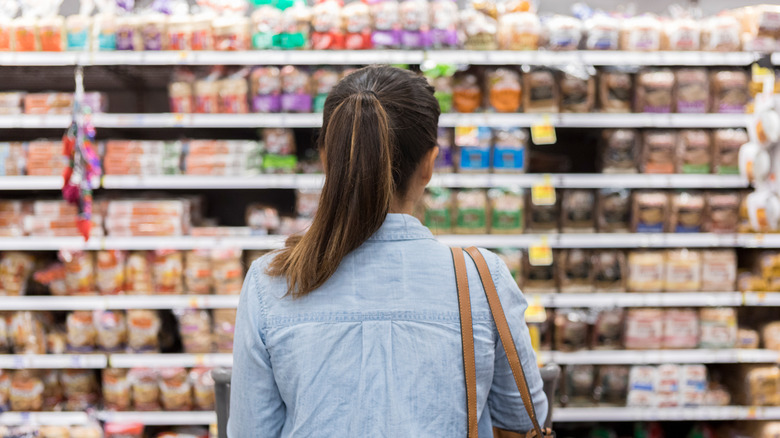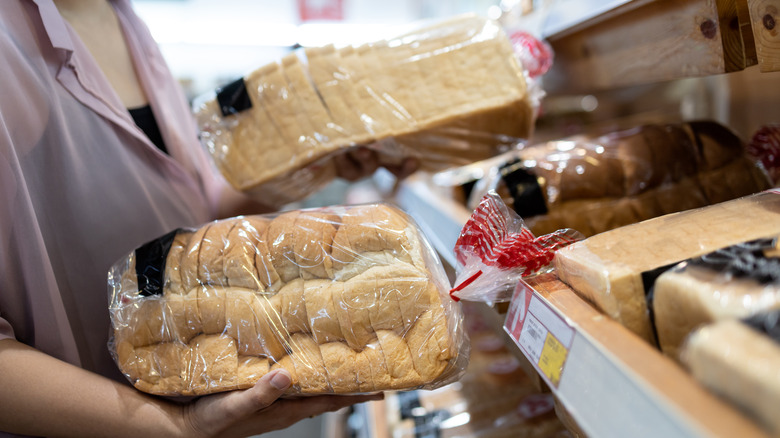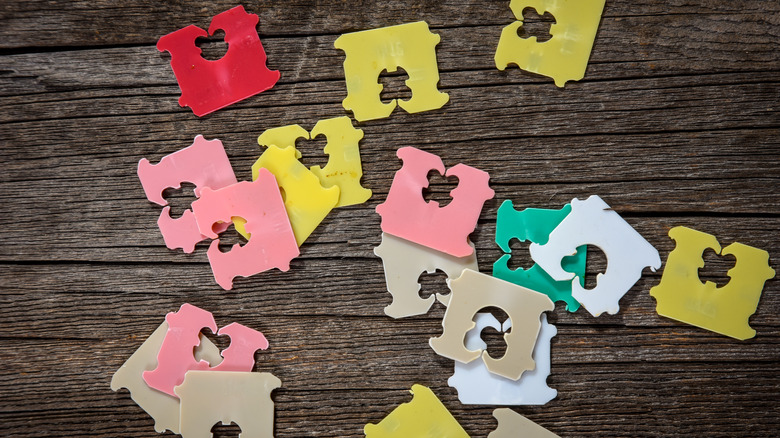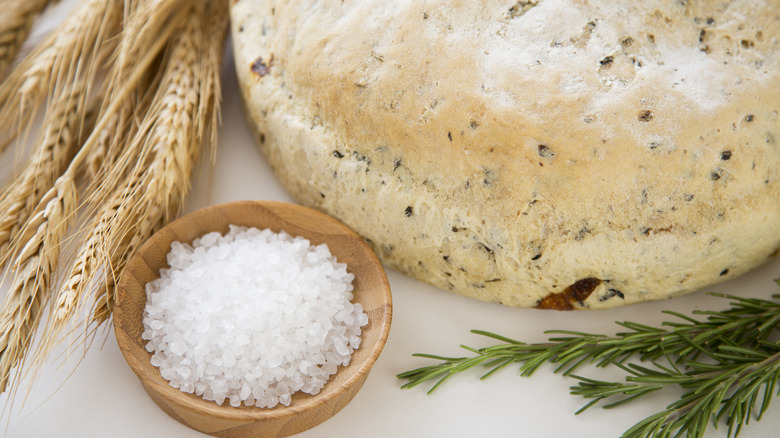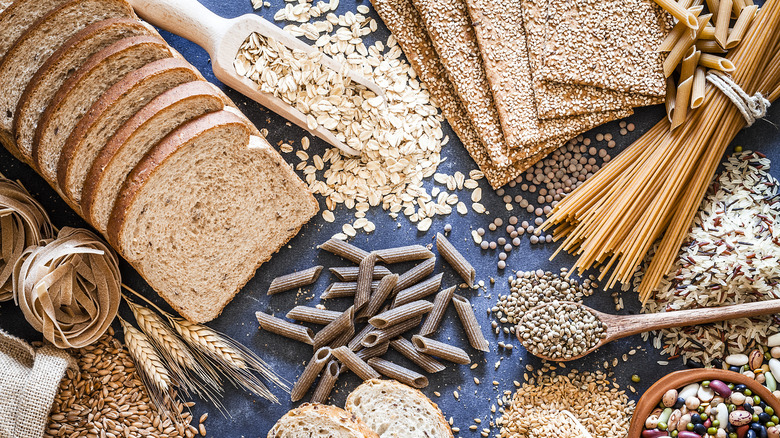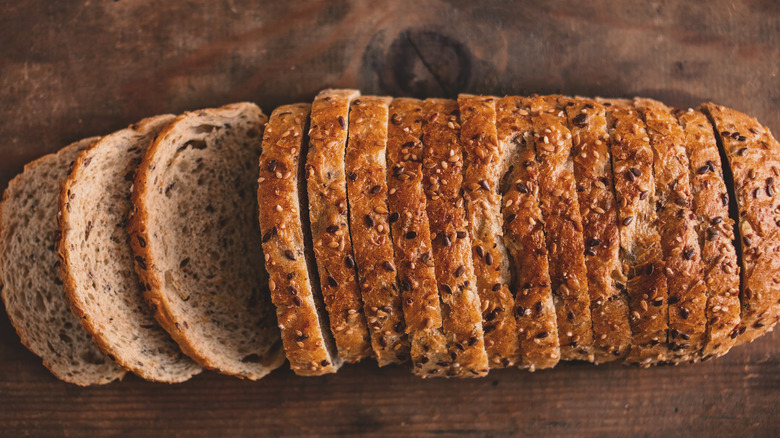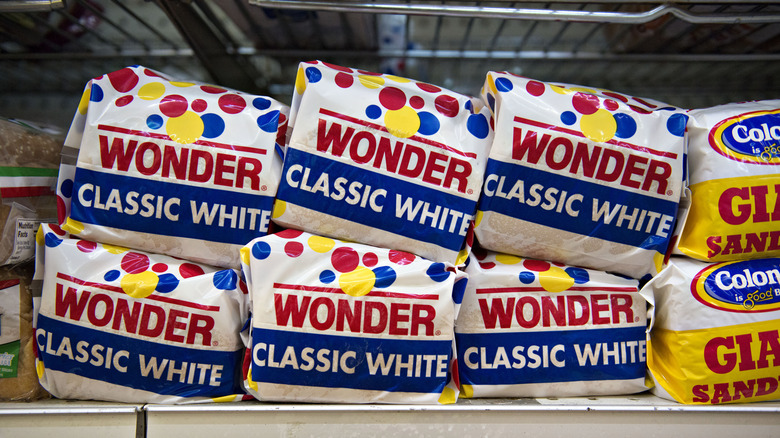8 Ways To Pick The Best Bread From The Grocery Store
Whether you're eating bread as a vehicle for nut butter or avocado, or you love to slap as many meats, cheeses, and toppings in between two slices as humanly possible, there's no denying that bread is a grocery store staple. But, how do you know you're getting the best bang for your buck in the bakery section? Bread comes in all different shapes and sizes, and not all bread is created equal. While it can be confusing to navigate the countless options and brands available depending on the grocery store or bakery you're shopping at, there are some guidelines that will help you choose more wisely.
To help you pick the best bread you possibly can every time you go grocery shopping, we've rounded up a list of tips and tricks to help you make your selection. For example, you may think you've got your bread game on point, but did you know the color of the twist ties or plastic tags may help make your selection easier? This list will enlighten you on the surefire ways to pick the best bread.
1. Choose the grocery store wisely
They say you shouldn't judge a book by its cover, but this theory doesn't exactly pan out when it comes to examining the appearance and cleanliness of a grocery store. With more than 70 million people reporting foodborne illness of some sort each year, there's good reason to proceed with caution when shopping for your food. Before you go spending all your hard-earned money you've budgeted for this week's groceries, we advise you to consider the source and head to the cleanest and most reputable store.
There are some telltale signs that a grocery store does not make cleanliness a high priority, and some of these may be outright visible, such as fruit flies, mouse traps, or other signs of bug infestations. If items in the freezer are soft or melting, it's a sign the store may not take temperature regulations seriously and may be violating health codes in doing so. Expiration dates, food storage, general cleanliness, and sanitation are all key ingredients to knowing whether or not your grocery store is safe. Before you go forking out on a loaf of bread, be sure to take a look at the general condition of your grocery store and choose where you shop accordingly.
2. Check the expiration date
Expiration dates aren't necessarily a key factor in deciphering whether or not your grocery store food is safe, but consumers should be in the habit of checking expiration dates before placing items in their cart. If the item is expired, it doesn't mean it's not safe to eat, but it does mean it will have a shorter shelf life. If you're not planning on consuming it right away, it's best to err on the side of not expired.
On average, bread is good for approximately five to seven days after it has expired, depending on where and how it is stored. When stored in a dry, cool place, expired bread is still relatively safe to eat unless it shows signs of molding. When placed in a refrigerator, you may prolong the shelf life of bread, but you'll also run the risk of causing the bread to go stale due to the cooler temperatures. If you choose to eat expired bread, be sure to check it for signs of mold as that could lead to foodborne illnesses (per USDA).
3. Note the color of the twist tie
If you're in a hurry and don't have the time to check or can't seem to locate the expiration date, the next best option is to check out the color of the twist tie or plastic tag around the loaf of bread to determine freshness. The twist tie or tag color indicates the day of the week the bread was baked, allowing grocery store staff to easily swap out older loaves for fresher ones, and also indicating freshness to customers.
Bread is a grocery store item that tends to maintain a strict delivery schedule, arriving at the grocery store five days per week. Bakeries also tend to be closed on Wednesdays and Sundays, so the color-coding system accounts for all other days, and is labeled as follows:
Monday – blue
Tuesday – green
Thursday – red
Friday – white
Saturday – yellow
An easy way to remember the system is to keep in mind that the colors are in alphabetical order. Some stores may also print a date on a plastic tag, but the date does not indicate the day it was baked — it's actually the sell-by date.
4. Avoid bread with high levels of sodium
It's no secret that Americans eat way too much salt, and it's also no secret as to why. With salt sneaking into every type of food from yogurt to salad dressings to frozen shrimp, it's unsurprising that high amounts of sodium are also found in a slice of bread. Salt isn't the devil as far as ingredients go. In fact, our bodies need a certain amount of salt to function properly. However, too much salt in our diet can cause blood pressure to spike as the heart works overtime to pump blood to the blood vessels. A spike in blood pressure won't cause immediate danger, but over time, may lead to problems like heart disease or a stroke.
Our best advice is to read the ingredients label and check the sodium content in your bread loaf so you can make a more informed decision. Seeded bread tends to yield lower salt contents, while other breads, including sourdough, are found to have salt levels as high as a serving of McDonald's French fries. To help you navigate the sodium content in your bread, look for the Percent Daily Value on the nutrition label. You'll want to choose a bread with less than 5% of your daily sodium intake per serving. Another way to determine sodium content is to look at the sodium per serving. A slice of bread with less than 115 milligrams of sodium per serving is considered low in salt.
5. Make sure your bread has fiber in it
If you're going to splurge on carbohydrates, you might as well make sure there's something in it for you, which is where fiber comes into play. Fiber is a type of carbohydrate that helps the body keep sugar cravings in check. The fiber found in whole wheat or sprouted bread also helps with the digestive system and promotes regularity (per Harvard T.H. Chan School of Public Health).
Not all bread is equivalent when it comes to fiber, and the same can be said for any carbohydrates, so it's important to check the label and ingredients to make sure your bread contains fiber-filled whole grains. Any type of bread that contains more than 4 grams of fiber per serving is considered a high-fiber bread, but you'll want to shop for bread with at least 2 or 3 grams.
Another indicator of fiber content is whether the bread is 100% whole wheat, which contains more fiber than bread that is made with refined grains or refined wheat. Oat bread is another high-fiber option, as the fiber found in oats may help lower cholesterol. Gluten-free bread may also contain higher levels of fiber and protein, but it's important to read the label, as some contain higher levels of sugar and refined flour.
6. Choose sprouted bread with whole grains
Another tip to help you select the healthiest bread possible from the grocery store is to look for sprouted bread with whole grains. Essentially, this means avoiding any breads with refined grains, which means a number of nutrients have been stripped from the product.
Sprouted bread with whole grains, seeded breads, or whole wheat breads are higher in nutrients, vitamins, fiber, and minerals. Sprouted whole grains are used in replacement of flour, and the sprouting is what makes the nutrients more available to the body by unlocking beneficial minerals and antioxidants. Sprouted bread has also been proven to aid in digestion, boost energy levels, and lower your glycemic index (from Healthline).
While some healthy foods may be presumed to be unappetizing to some, sprouted bread is worth expanding your taste buds for. It has a sweet, nutty flavor, and with all the health benefits that outweigh any white bread option, it seems like a no-brainer way to boost your daily dose of vitamins and nutrients.
7. Avoid white bread
Although white bread may conjure up some delightful nostalgia for the primary-colored Wonder Bread label, that's really as good as it gets as far as white bread is concerned. There are myriad reasons why you shouldn't touch the stuff, but we'll try to keep it brief.
For starters, there is nothing nutritionally redeeming about white bread. White flour is highly processed and stripped of all fiber, protein, nutrients, minerals, and antioxidants. What it lacks in nutritional benefits it more than makes up for with its health consequences. For example, white bread is generally loaded with salt and sugar, two things that cause high blood pressure and headaches, as well as many long-term diseases. It also causes more cravings unlike its sprouted whole wheat counterpart, which has protein and fiber to help curb cravings. If the negative consequences of consuming white bread aren't enough, consider the fact that it has a shorter shelf life than all other breads and will mold much faster.
8. Opt for bakery bread over prepackaged
Homemade bread from scratch might not be in the cards for everyone, but the next best thing to owning your own bread maker is selecting fresh bread from your local bakery. Before you head straight for the commercial bread section, consider passing through a bakery first to check out their selection of fresh-baked goods. It may mean you'll have to slice your sandwich bread by hand, but it also saves you a lot on preservatives, ingredients, and in many cases, cost.
Artisan bread not only tastes better, but it is typically healthier than commercial brands as it doesn't include all the preservatives, additives, or the laundry list of ingredients you cannot pronounce. The process of baking it often uses slower methods and longer fermentation as opposed to factory-produced bread, which is rapidly baked to meet production demands. It also opens the door to different uses for your bread as opposed to the pre-sliced version, which limits what you can actually do with it. A loaf provides endless options for slicing and dicing, whereas pre-sliced bread basically dictates itself as toast or a sandwich.
